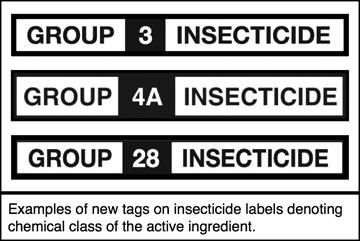Using insecticides
Insecticide use should be the last resort in managing insect pests, but may be necessary even with a careful integrated pest management plan in place. Herbivorous and nuisance insects are mobile and tend to establish at their preferred food source, which may just happen to be lawns, golf courses or sports fields. Most turfgrass managers realize that maintaining acceptable appearance and turf health will involve the use of synthetic pesticides, and that proper stewardship involves careful, responsible and prudent application of these compounds.
Safeguarding beneficial insects in the landscape, particularly bees and other pollinators, is a critical issue that must be considered before insecticide use. New bee advisory icons are now placed on the label of insecticide products that carry risk for affecting pollinators. When using turfgrass insecticides, several practical measures for protecting these nontarget insects should be implemented.
- Mow all areas before apply insecticides. Mowing will remove most of the weed flowers and reduce bee foraging in insecticide-treated areas.
- Avoid treating weedy areas, particularly those that contain flowering weeds.
- Remove weeds with an herbicide or by another method before insecticide treatment.
- Apply in early morning or late evening when bees are less likely to be actively foraging.
- Use buffer strips between treated areas and landscape beds.
- Wait until after spring petal fall of flowering trees and shrubs to treat.
- Consider alternative chemistries.
Insecticide resistance — the development of insect populations that can tolerate once lethal insecticide doses — is another major problem. Chinch bugs, billbugs, fall armyworms and Japanese beetles are examples of turfgrass insects that have had confirmed cases of insecticide resistance. Several management strategies should be incorporated to reduce the risk of resistance development.
- Use proper cultural practices to maximize plant health and reduce or eliminate the need for pesticides.
- On plants with a history of the pest problem, apply pesticides preventively based on the pest biology and before the plant expresses symptoms. This practice will allow treatment of smaller pest populations.
- Consider the use of multisite pesticides first.
- Limit the use of site-specific pesticides from the same class during a single season.
- If a large pest outbreak occurs, use a multisite partner tank-mixed with a single-site pesticide.
- Rotate site-specific pesticides so a constant selection pressure is not put on the pest population.
A crucial aspect of a resistance management strategy is to know not only the insect, but also the insecticide being used. Insecticides are grouped into chemical classes according to their biochemical mode of action on the pest. To effectively implement number 4 or 6 above, products from the same group should not be applied exclusively and should be rotated with insecticides from another class. Current insecticide labels include banners indicating the chemical class group, which should be used to facilitate resistance management.
 Banners on insecticide labels indicate class or mode of action.
Banners on insecticide labels indicate class or mode of action.